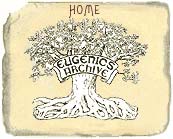
Eugenics Laws Restricting Immigration
Paul Lombardo, University of Virginia
Congress passed America's first naturalization law in 1790. It limited the privilege of US citizenship to "free white persons." About a century later, immigration laws began to restrict who could enter the country. The 1882 Act to Regulate Immigration prohibited entry to "any person unable to take care of himself or herself without becoming a public charge". The law was designed to exclude immigrants whose undesirable conditions might prove costly to society – including convicted criminals, the poor, and the mentally ill. In that same year, the Chinese Exclusion Act was the first measure to specifically target immigrants by race or ethnicity.
In the 1890's the federal government assumed sole jurisdiction to monitor immigration, a task that had previously been delegated by contract to states with port cities. The government built a depot on Ellis Island in New York Harbor, through which all immigrants were to be processed. Outbreaks of smallpox, typhus and cholera in New York between 1882 and 1892, heightened concern about the possibility of alien contagion prompted the adoption of individual health inspections for each arriving immigrant – especially for the contagious eye disease trachoma.
Pressures for further immigration restrictions arose from several quarters of American society. Advocates for American workers wanted to forestall competition from cheap foreign labor. The Boston-based Immigration Restriction League joined this chorus of alarm with calls to require a "literacy test" as a condition of entry into the United States. The League's proposal was given more credence with the publication of Carl Brigham's Study of American Intelligence, which cited the supposed low quality of army recruits of southern and eastern European heritage.
The sheer number of new arrivals troubled many U.S. citizens. In the late 1870's, the annual average number of immigrants fell just short of 150,000. By the turn of the century, that number had increased to almost 800,000, and in 1907 it passed 11/4 million. As the numbers of immigrants increased, eugenicists allied themselves with other interest groups to provide biological arguments to support immigration restriction.
In 1911, Immigration Restriction League President Prescott Hall asked his former Harvard classmate Charles Davenport of the Eugenics Record Office (ERO) for assistance to influence Congressional debate on immigration. Davenport recommended a survey to determine the national origins of "hereditary defectives" in American prisons, mental hospitals and other charitable institutions. Davenport appointed ERO colleague Harry Laughlin to manage the research program.
The Public Health Service (PHS), whose duties included performing medical inspections of disembarking passengers at Ellis Island, also adopted eugenic arguments to help stem the flood of "inferior stock" represented by the new immigrants. Beginning in 1914, the Surgeon General and a number of senior officers in the PHS became publicly aligned with the eugenics movement. They took prominent roles in eugenic organizations and published articles to support the eugenicists' position in the immigration restriction debate. The key role of PHS physicians as medical guardians of U.S. ports – particularly at Ellis Island – gave the PHS additional credibility.
Without specific support from eugenicists, by 1917, Congress had expanded the legal definition of those "likely to become a public charge" to include: "all idiots, imbeciles, feebleminded persons, epileptics, insane persons…," "persons of constitutional psychopathic inferiority…, and" "mentally or physically defective..," Later involvement of eugenicists further broadened that definition by specifying the immigrant groups most likely to represent what Laughlin called the "socially inadequate."
In 1920, Laughlin appeared before the U.S. House of Representatives Committee on Immigration and Naturalization. Using data for the U.S. Census Bureau and a survey of the number of foreign-born persons in jails, prisons and reformatories, he argued that the "American" gene pool was being polluted by a rising tide of intellectually and morally defective immigrants – primarily from eastern and southern Europe. Sympathetic to Laughlin's message, Committee Chairman Albert Johnson of Washington State appointed Laughlin as "expert eugenics agent."
In this capacity, Laughlin conducted research from 1921 to 1931. He took a fact-finding trip to Europe, used free postage to conduct large-scale surveys of charitable institutions and mental hospitals, and had his results published by the Government Printing Office. His research culminated in his 1924 testimony to Congress in support of a eugenically-crafted immigration restriction bill. The Eugenics Research Association displayed a chart beneath the Rotunda of the Capitol building in Washington showing the cost to taxpayers of supporting Laughlin's "social inadequates."
The resulting law, the Immigration Restriction Act of 1924, was designed consciously to halt the immigration of supposedly "dysgenic" Italians and eastern European Jews, whose numbers had mushroomed during the period from 1900 to 1920. The method was simply to scale the number of immigrants from each country in proportion to their percentage of the U.S. population in the 1890 census – when northern and western Europeans were the dominant immigrants. Under the new law, the quota of southern and eastern Europeans was reduced from 45% to 15%. The 1924 Act ended the greatest era of immigration in U.S. history.
Upon signing the Act, President Calvin Coolidge commented, "America must remain American." This phrase would become the rallying cry of anti-immigration sentiment until after World War II. The eugenic intent of the 1924 law and the quota system it established remained in place until they were repealed by the Immigration and Nationality Act of 1965.
